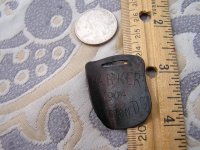Need some advice - I recently found this brass watch fob, which is really cool because it was a promotional piece for the Democratic presidential candidate in 1904 and designed to look like a railroad baggage tag (Parker, bound for Washington DC...) so it's got three-way appeal to me. But it would sure display better flat. It's one of the coolest things I've found, so I don't want it to break in two for sure. (p.s. - Teddy Roosevelt clobbered Parker in the election.)
You are using an out of date browser. It may not display this or other websites correctly.
You should upgrade or use an alternative browser.
You should upgrade or use an alternative browser.
Can I safely flatten this brass political watch fob?
- Thread starter Iggyks
- Start date
dirt weasel
Full Member
- Joined
- Apr 19, 2010
- Messages
- 232
I have done it to coins.
Place between two pieces of hardwood wrap in a thin cloth and proceed with a sledge hammer, slowly checking results. don't worry about it NGC or PCGS won't be grading it and the results should be fine for display.
Place between two pieces of hardwood wrap in a thin cloth and proceed with a sledge hammer, slowly checking results. don't worry about it NGC or PCGS won't be grading it and the results should be fine for display.
Ice Scratcher
Elite Member
- Joined
- Oct 13, 2012
- Messages
- 18,347
I concur with the above discussion^
The patina might flake off at the bends though. But you can brighten it up and make it uniform looking with some steel wool...
<°)))>{
The patina might flake off at the bends though. But you can brighten it up and make it uniform looking with some steel wool...
<°)))>{
pryan67
Forum Supporter
I would use a vise personally....slowly...making sure that it's well padded with a towel to avoid scratches....
GREAT find (although I disagree with the party it represents ) I'd love to find something like that.
) I'd love to find something like that.
GREAT find (although I disagree with the party it represents
 ) I'd love to find something like that.
) I'd love to find something like that.dirt weasel
Full Member
- Joined
- Apr 19, 2010
- Messages
- 232
Okay cool - pretty much how i was going to approach it but clamping the boards in a vise and slowly applying pressure.
Been there done that. You could start with that method but it will not go completely flat. For some reason several instant snaps of a sledge will get you very close to perfectly flat but a vice will allow for metal memory.
Why I say go slow is because if you hit it too hard it will actually bend in the other direction...just flip it over and whack it again, convex side up to hammer.
Last edited:
pryan67
Forum Supporter
Also, if you DO use a vise, make sure you not only protect it, but use blocks of wood, so that it goes as flat as possible. Most (all?) vises have grooves on them...so that could impact the flatness.
Also, if you DO use a vise, make sure you not only protect it, but use blocks of wood, so that it goes as flat as possible. Most (all?) vises have grooves on them...so that could impact the flatness.
Definitely!
georgeinsc
Elite Member
Show us a picture when you get flattened.
pjcd
Full Member
Use a dead blow hammer and protect it with thick leather.
Show us a picture when you get flattened.
Definitely!!
Yooper Rich
Senior Member
Yup vice with a couple pieces of wood and I use leather with the wood too. Good luck and give a peek at it when done.
waltr
Elite Member
In my experience many thin brass objects recovered had 'age hardened' and are brittle and crack or break when trying to straighten.
For these 'hardened' brass objects they should be annealed first.
For these 'hardened' brass objects they should be annealed first.
In my experience many thin brass objects recovered had 'age hardened' and are brittle and crack or break when trying to straighten.
For these 'hardened' brass objects they should be annealed first.
man i was about to post this, such a great comment ! annealing is the only way to prevent the cracking for sure. but does remove patina.
Ice Scratcher
Elite Member
- Joined
- Oct 13, 2012
- Messages
- 18,347
I've been reading about annealing... it says to heat to a dull red... even on a small/old piece like this I get it that hot?
It's going to be tough to get that whole piece an even "dull red".... Just get it real damn hot, then quickly quench it in water.. That should be plenty good enough..
<°)))>{
waltr
Elite Member
The only other thing I can say is:
If you value this piece and are unsure of what can be done then DO NOT do it.
Either find someone that has experience restoring old brass objects or leave it alone.
Use other brass 'age hardened' objects that do not have value to you for experimenting. Not the one you really like.
If you value this piece and are unsure of what can be done then DO NOT do it.
Either find someone that has experience restoring old brass objects or leave it alone.
Use other brass 'age hardened' objects that do not have value to you for experimenting. Not the one you really like.
Estima8tor
Elite Member
It's good, display as is.


